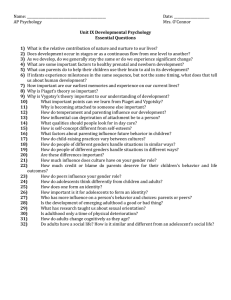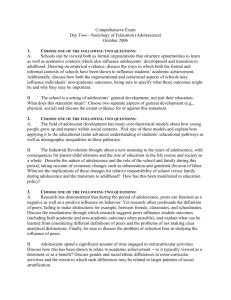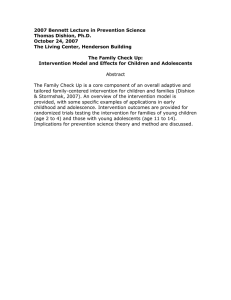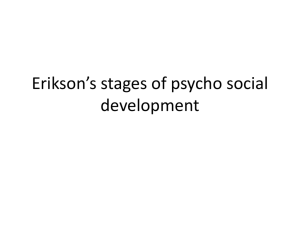Adolescence Personality and Sociocultural Development
advertisement
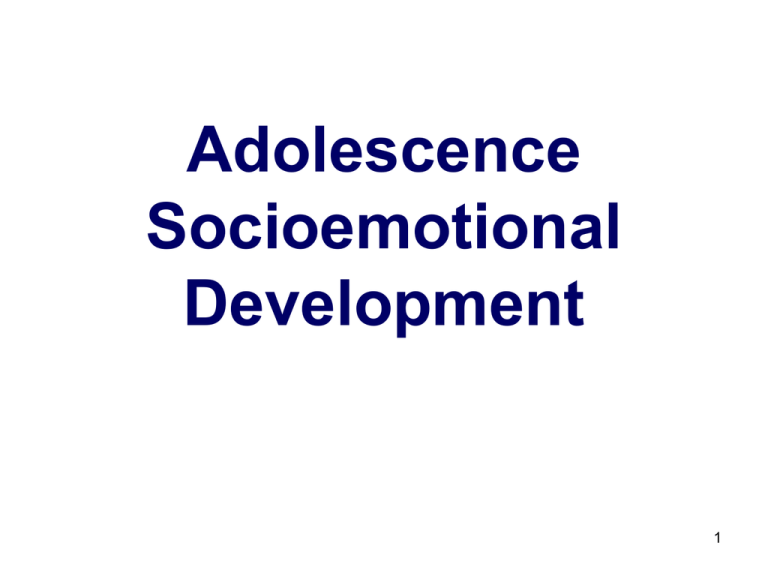
Adolescence Socioemotional Development 1 Adolescents Must Confront Two Major Tasks 1- Achieving autonomy from their parents 2- Forming an identity – creating an integral self that harmoniously combines different aspects of personality. 2 Who Am I? Where Do I Belong in the World? 1- Adolescents’ intellectual capabilities become adult like. They can now understand abstract issues. 2- The dramatic physical changes during puberty make adolescents acutely aware of their own bodies. 3 Self-Concept 1- Adolescents distinguish others’ views of themselves from their own perceptions. “Others look at me as laid-back and relaxed, but really, I’m often nervous and emotional.” 2- During the earlier years of adolescence, teenagers may want to view themselves in a certain way and may feel concerned when behavior is inconsistent with their view. “I’m a sociable person and love to be with people.” 4 Self-Esteem • • • • Gender SES Race Ethgender 5 Independence and Interdependence • The issue of the “generation gap” and the turbulent conflicts between parents and adolescents has been exaggerated. • Daniel Offer’s study of 6,000 adolescents in 10 diverse nations reveals that the vast majority of teenagers all over the world get along well their parents. 6 John Hill Definition of Independence • • • • • Self-regulation Making your own judgments Regulating your own behavior Think for yourself Definitions of autonomy that stress freedom from parental influence need to be reevaluated. 7 Interdependence • Reciprocal dependence • Social relationships are interdependent Example: Bosses depend on their workers to produce, and workers depend on their bosses to manage the enterprise. 8 Identity Development Eric Erikson Identity Vs. Identity Confusion 9 Identity Development James Marcia Four Modes or Identity Statuses 1- Identity Achievement 2- Identity Foreclosure 3- Identity Diffusion 4- Identity Moratorium 10 1- Identity Achievement • The identity status of those who have gone through an identity crisis, considered various alternatives, and then committed to a certain identity. • Adolescents in this status have the most balanced feelings towards their parents 11 2- Identity Foreclosure • The identity status of those who have made commitments to an identity without going through a period of crisis in which they explored alternatives. Instead, they accepted others’ decisions about what was best for them. • They are happy and self-satisfied. • They have a high need for approval. • They tend to be authoritarian. 12 3- Identity Diffusion • Those who have neither gone through an identity crisis nor made commitments. • Teenagers who have experienced rejection from detached and uncaring parents. • They may become drop outs, or may turn to drugs to run away from responsibility. • They are unable to have a close relationship 13 4- Moratorium • Explored various alternatives, but are not committed and are still in the midst of an identity crisis. • They struggle with conflicting values and choices and are always faced with unpredictability. • They show high anxiety and experience psychological conflict 14 Family Dynamics 1- Parenting Styles 2- Conflict 3- Family Alliances 4- Leaving Home 15 Parenting Styles 16 Effects of Different Parenting Styles A U T O R I T A R I A N Tend to produce children who are: Withdrawn Fearful Dependent Moody Unassertive Irritable 17 Effects of Different Parenting Styles P E R M I S S I V E Tend to produce children who are: Rebellious Aggressive Self-indulgent Socially inept Creative Outgoing 18 Effects of Different Parenting Styles A U T H O R I T A T I V E Tend to produce children who are : Self-reliant Self-controlled Socially competent With high selfesteem Do better in school 19 Effects of Different Parenting Styles I N D I F F E R E N T They produce children who are: The child feels free to give rein to the most destructive impulses 20 The Judge 21 The Psychologist 22 The Consoler 23 The Critic 24 The Know-It-All 25 The Moralist 26 The Commander-in-Chief 27 2- Why Is Conflict between adolescents and Parents Greater During Early Adolescence 1- At the start of adolescence, the relation is asymmetrical. 2- By the end of adolescence, the relation is symmetrical. 3- Differing definitions of and rationales for appropriate/inappropriate behavior. 4- The newly sophisticated reasoning of adolescents leads teenagers to question parents rules. 28 3- Family Alliances • It is important for parents to maintain a united front and a distinct boundary between themselves and their children. • A close bond between a child and one parent that excludes the other can be destructive. • Adolescents try to test new roles to achieve new identity, and parental authority may be severely tested. 29 4- Leaving Home Three Dimensions of Family Functioning 1- Cohesion 2- Adaptability 3- Quality of Communication 30 Relationships with Peers 1- Peers Provide the opportunity to compare and evaluate opinions, abilities, and physical changes – a process called social comparison 2- Peers may serve as a reference groups – groups of people with whom one compares oneself. 31 Belonging • Cliques • Crowds • Dating 32 Adolescence Dating • It can be used as entertainment. • It can be used to develop a sense of one’s own identity. • Dating is often a superficial activity. • Participants never really expose themselves emotionally. • They don’t really let down their guard. 33 Sexual Orientation 1- Genetic and biological factors may play a part. Studies of twins Structure of the brain 2- Family, peers, and environmental factors may play a role. 34 When Adolescence Goes Awry • Risk Taking • Drug Abuse – Tobacco – Alcohol – Marijuana – Cocaine – Heroin 35 Risk Factors for Depression 1- Biological Factors 2- Negative body image 3- Low popularity 4- Low achievement in school 5- Family dysfunction 6- Marital Discord 36 Depression Protective Factors 1- Good relationships with parents 2- A particular area of competence and expertise 3- A role that includes responsibility 37 Why Is Depression More Common Among Girls? Girls are worried about doing well at school and about being popular. Girls are more apt than boys to experience helplessness Boys externalize the stress and act aggressively and may turn to alcohol Little evidence links hormonal production to depression 38 Reasons for Suicide 1- Depression 2- Perfectionism and high levels of anxiety 3- Family conflicts 4- Abuse and neglect 5- Drug and alcohol abuse 6- Cluster suicide 7- Access to and use of firearms 39 Juvenile Delinquency • Undersocialized Delinquents – Tend to be relatively aggressive early in life – Tend to be rejected by peers – They fail academically – Tend to be less intelligent – Some are diagnosed with ADHD • Socialized Delinquents – Commit petty crimes, but don’t continue lawbreaking 40



